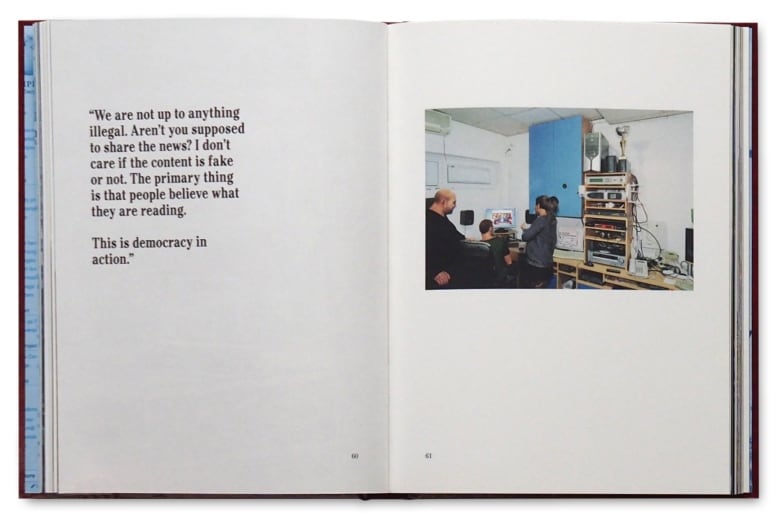This photojournalist faked an entire book to highlight how hard it is to spot misinformation
Jonas Bendiksen intended manipulated images to be caught, but no one noticed

When photojournalist Jonas Bendiksen released a book about the fake news industry, he got messages from people thanking him for covering such an important issue.
But he says no-one noticed one thing about the book: everything in it was also fake.
"The whole intention was for people to find this out … the problem is that didn't happen," Bendiksen told The Current's Matt Galloway.
His work, The Book of Veles, is based in a town of the same name in North Macedonia. Veles made international headlines in 2016, as the home of a fake news industry that was pumping out misinformation on websites targeted at U.S. voters mulling over a presidential election.

Bendiksen wanted to explore how misinformation and disinformation has been developing in the years since, from articles riddled with lies and half-truths, to manipulated images and deepfake videos.
So he went to Veles in 2019 and 2020, and took pictures of empty spaces, both outdoors and inside. Back home in Norway, he populated those real images with figures that were completely digital, posed and lit to fit into their previously empty surroundings.
"While the story of what happened in Veles is a true one, all the characters in my photographic documentary are basically a computer game character," he said.
He wanted to find out if "one averagely geeky photographer" could spend some time on YouTube learning the techniques, and then "generate fake characters, a fake storyline, a fake documentary that has no basis in fact."
"I got the sense that if I could actually do this, it would say something frightening about the information landscape that we're headed into," he said.
'Something fishy' in every photo
Bendiksen has not revealed all the specifics of what he did to each image. But he said he added "breadcrumbs" that he thought might raise suspicion in the viewer — things like a bear wandering around town. The introductory text in the book is also created using artificial intelligence, generated from media reports about fake news. Bendiksen didn't write a word of it.
"There's also objects, animals, other things I put into it, so basically every picture in the project has something fishy going on," he told Galloway.



"I thought all of that would make people go, 'You know, there's something fishy going on in this work, what is it?' And I wanted to sort of play into that discussion," he said.
But in the weeks after the book was published in May, nobody raised any concerns with Bendiksen.
He decided it was time for one more "stress test," so he submitted it to Visa pour l'Image, a prestigious photojournalism festival that took place in Perpignan, France in September.
Bendiksen wanted to see if the experts noticed: "Could this fake documentary actually be accepted as a real reportage by seasoned editors?"
It turns out that it could. "They immediately accepted it," he said.
Bendiksen's images were viewed by photographers, editors and industry insiders on a large screen.
When no one spotted the deception, he decided to reveal the truth.
In an interview with Wired, the festival's director Jean-François Leroy said his organization had known and trusted Bendiksen for years.
"I think Jonas should have told me it was a fake," he said, adding that if he was in on the secret, they could have revealed it and hosted a discussion as part of the festival's program.
Bendiksen said he's not the type of "person who particularly enjoys going around and scamming people."
But he thinks that what he did was "an important experiment for us telling stories in the journalism and photography communities."
Mass-produced misinformation
While identifying misinformation and disinformation online is already an issue across the world, Bendiksen believes things will only get worse as the technology behind it develops.
"Give it a few years, we will have this whole synthetic layer on top of it, where you will have misinformation not even produced by people, but by machines, and in quite great quantities," he said.

He thinks there needs to be better education around how to spot manipulated content, perhaps even as part of school curricula.
"How can we make our young, the next generations, better at navigating this very difficult mix of information, to find credible information in this mess?" he said.
He thinks the project has changed his own outlook.
Bendiksen says the project has changed his own outlook, and that from now own he'll view photography, as well as other kinds of stories, with a more critical eye than in the past.
"I see now how easy it is to reproduce fake versions of this," he told Galloway.
The Book of Veles is available from Gost Books.
Written by Padraig Moran. Produced by Alison Masemann.
